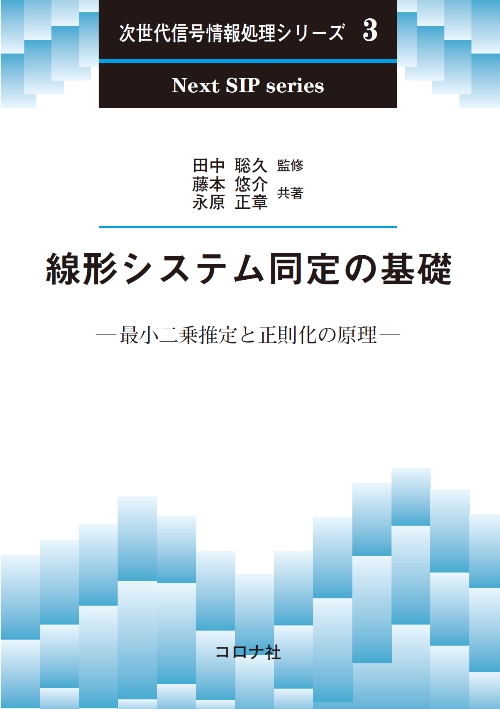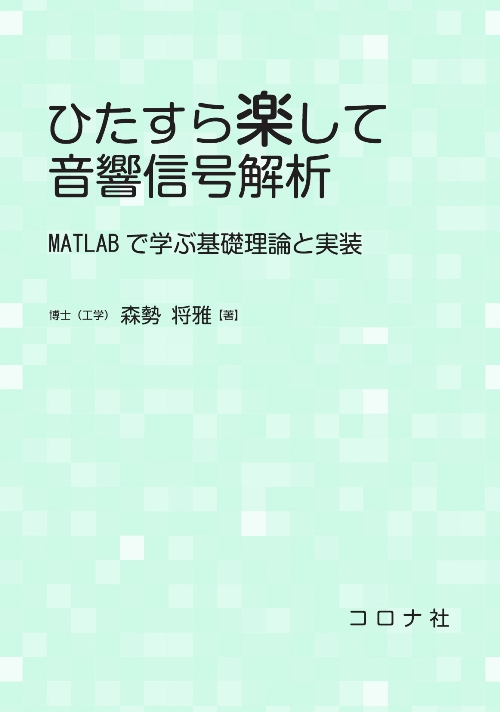
英語で学ぶ 制御システム設計
章末問題には国内外の大学院受験問題・分析的な吟味を必要とする問題も掲載した。
- 発行年月日
- 2022/04/15
- 判型
- A5
- ページ数
- 228ページ
- ISBN
- 978-4-339-03238-3
- 内容紹介
- まえがき
- 目次
- レビュー
- 書籍紹介・書評掲載情報
- 広告掲載情報
産業ロボットや掃除ロボット,および自動運転など幅広いシステムの高性能を保障するため,制御理論が必要である。一方,大学の制御理論関連授業は,主にモデルに基づく分析的手法を中心に,制御理論を教えているため,数学が多く使われ,学習者が短い期間でその真髄を理解するのは非常に難しい。著者らは長年大学生や技術者を対象に,制御理論について教鞭を取ってきた。近年,ScilabやMATLAB/Simulinkなどのソフトウェアは,学修中のアハ体験に大きく促進し,学習者が自分で発見的に学修することを容易にしている。本テキストも,MATLAB/Simulinkを勉学のツールとして使用することを前提としている。また,近年,グローバル化に伴い,一部の授業が英語で行う大学も増えている。その中,高校生くらいのレベルでの英語で制御理論の専門知識を平易に解説するテキストは学修の垣根を低くするのに重要である。これらのことを背景に,著者らは,英語で本テキストを執筆することにした。
「読者対象」
制御に興味を持っている大学生,専門学校生と技術者。高校数学II程度の数学知識が必要。
「書籍の特徴」
難しい数学の導出を最小限にし,基本概念およびその物理的な意味をわかりやすく説明し確実に理解できるようになっている。特に,アームロボットと台車型倒立振子という二つの物理系を対象に,制御問題と手法を一貫して検討している。また,章末問題を基本問題と発展問題に分け,自分で進んでチャレンジできるようになっている。
「各章について」
第1章では,具体的な制御例をあげて制御の基本概念を説明し,制御工学で学ぶことを述べている。
第2章では,制御を勉強するために,最小限の数学基礎を導入している。
第3章では,簡単な機械要素と電気回路の常微分方程式からシステムの内部状態を表現する手法(状態空間表現)を説明した後,ラプラス変換を導入して伝達関数の必要性を理解する。さらに,非線形システムをどのように線形近似するかを,具体例を通して述べている。
第4章では,ブロック線図によるシステム表現法とシステム分析ツールである周波数応答の概念を説明している。
第5章では,まず,簡単な1次系と2次系を使って,動的システムの挙動を理解した後,システムの安定判別法を述べている。前半のこれらの内容により,後半の制御系解析・設計の基礎を築き上げる。
第6章では,制御系解析の基本的な考え方を説明し,特に,1次系と2次系を基に,システム設計で主に用いられている各種パラメータとそれらの関係を説明している。
アームロボットを例に,第7章では伝達関数に基づく設計法を,第8章では状態空間での設計法を説明している。
第9章では,制御系実装に係る問題と解決法を述べている。
第10章では,制御性能を高めるために,アームロボットを例に,伝達関数を用いて制御則をどのように改善していけばよいか,ステップバイステップで説明し,また,台車型倒立振子を例に,状態空間で制御性能改善のシステム構成を,順を追って説明している。
「著者からのメッセージ」
産業分野から日常生活の隅々まで広く応用されている制御技術は,現代社会を支える不可欠なものである。しかし,数学の知識を多く要する制御理論は,初心者にとって晦渋で学習のモチベーションを維持するのは難しい。著者らもそのような苦い経験をしており,振り返ってみると,どうすれば多くの方々にこの素晴らしい技術に興味を持ち,積極的に学び,広く使っていただくか,長年教育実践を繰り返し模索してきた。今回刊行されたこのテキストは,著者らの長年教育の結晶である。皆さんの制御理論勉強に少しでも役立てれば幸いである。
制御(control)とは,「ある目的に適合するように,対象となっている物に所用の操作を加えること(JIS)」と定義されている。動植物を操ること,ものを操ることなどすべて「制御」であり,さまざまな手法が提案され実行され,“目的”に合う成果を上げている。本書では,電気機械システムを対象例に,対象を数式で表現し,それに基づいて目的に沿うように操る手法の基本を解説している。制御は目的通りの結果が得られたかどうかで評価されるべきものなので,マイクロコントローラを用いた実装についても述べ,実装を意識したモデリング,解析,設計のプロセスを解説した。なお,国際的に活躍する技術者となる訓練のために,本文は平易な英文で記述し,重要語には対応する日本語を併記した。“英文で学ぶ教科書”としても活用して頂きたい。章末問題は,基本問題と発展問題に分けており,発展問題は国内海外の大学院受験問題および分析的な吟味を必要とする問題を中心に選定するとともにすでに学習した知識を復習できるように問題の作成を工夫したので,理解を深める学習の一助となることを願っている。また,“教科書”は,考え方の基本が書かれているものであるが,日々新しいアプローチ法が開発されているので,読者の皆様には,この基本の考え方を実世界にどう適用し,どう修正・発展すれば“目的”を達成できるのかを考え,適応する手法を身につけて頂きたいと思う。
最後に,本書は筆者らのこれまでの大学内外における教育経験に基づいて執筆したものである。一緒に学んだ学生・技術者の方々にこの場を借りて感謝致します。
原稿を詳しくチェックし貴重な助言をくださった中国中南大学の李旻氏,中国湖南工業大学の趙凱輝氏,清水建設株式会社技術研究所の宮本皓氏,中国地質大学(武漢)の李美柳氏,周宇健氏,王澤文氏,趙大双氏と寧子昊氏に御礼を申し上げます。また,出版にあたり心暖かく見守ってくださったコロナ社に深く感謝致します。
2022年2月
佘錦華,禹珍碩,大山恭弘
Preface
Control is defined as adding necessary operations to a target object to suit a certain purpose (JIS). Manipulating animals and plants, operating things, etc. are all belong to the category of control. Various methods have been devised and implemented. Fruitful results that suited purposes have been achieved. In this book, we use electrical and mechanic systems as examples to explain the fundamental methods of describing systems by mathematical formulas and manipulating them according to purposes.Since control should be evaluated based on whether or not desired results are obtained, we also provide some explanations of the microcontrollerbased implementation of a control system and explain implementationconscious modeling, analysis, and design processes. To train engineers who play an active role internationally, we wrote the book in plain English and also added corresponding Japanese translations for important terms.We hope this book are used as a textbook to learn control engineering in English. Excise problems at the end of each chapter are divided into basic and advanced levels. Advanced-level problems were selected from graduate-school entrance examinations in Japan and from abroad or those requiring analytical scrutiny. We also tried to prepare excise problems in such a way that one can review the previously studied knowledge as much as possible. We hope this will play a role in helping readers deepen their understanding. In addition, a textbook mainly describes the basic way of thinking, while new approaches are being developed every day, Thus, we hope that readers think about how to apply the basic principle to the real world and how to modify and improve it to achieve your goals, and master adaptive techniques.
Finally, since this book was written based on our educational experience both inside and outside the university, we would like to take this opportunity to thank the students and engineers who studied with us. We would also like to express heartfelt appreciation to Prof. Min Li of Central South University and Prof. Kaihui Zhao of Hunan University of Technology,China; Dr. Kou Miyamoto of the Institute of Technology, Shimizu Corporation,Japan; and Dr. Meiliu Li, Mr. Yujian Zhou, Mr. Zewen Wang, Mr.Dashuang Zhao, and Mr. Zihao Ning of China University of Geosciences,Wuhan, China for their careful checking of the manuscript and for theirvaluable advice. We are deeply grateful to Corona Publishing Co., Ltd. forwarmly watching over the publication.
February 2022
Jinhua She, Jinseok Woo, Yasuhiro Ohyama
1.Overview of System Control
1.1 Control and Control System
1.2 Positioning Control of Arm Robot
1.3 Classification of Systems and Control Systems
1.4 Key Points of Control Engineering
Problems
2.Mathematical Foundations of Control Theory
2.1 Complex Number
2.2 Trigonometric Functions
2.3 Laplace Transform
2.4 Logarithmic Graph
2.5 Unit of Gain
Problems
3.Modeling of Dynamic Systems
3.1 State-Space Representation
3.2 Transfer Function
3.3 Linear Approximation Model
Problems
4.Block Diagram and Frequency Response
4.1 Equivalent Conversion of Block Diagram
4.2 Frequency Response
4.3 Nyquist Plot
4.4 Bode Plots
Problems
5.Stability Analysis
5.1 First-Order System
5.2 Second-Order System
5.3 Routh’s Stability Criterion
5.4 Nyquist Stability Criterion
5.5 Evaluation of Stability Margins using Bode Plots
Problems
6.Characteristics of Control System
6.1 Transfer Characteristics
6.2 Transient Characteristics
6.3 Steady-State Characteristics
Problems
7.Transfer-Function-based Control-System Design
7.1 Basic Consideration in Control-System Design
7.2 Internal-Model Principle
7.3 Design of PID-Control System
7.4 Two-Degree-of-Freedom Control System
7.5 Various PID-Control Systems
7.6 A Design Example
Problems
8.Control-System Design in State Space
8.1 System Description
8.2 Controllability and Observability
8.2.1 Controllability
8.2.2 Observability
8.3 Design of State Feedback
8.3.1 Pole-Placement Method
8.3.2 Linear-Quadratic Regulator
8.4 State Observer
8.5 Observer-Based Control System
8.6 A Design Example
Problems
9.Controller Implementation
9.1 Procedure of System Implementation
9.2 Model Reduction
9.2.1 Treatment of Small Time Constants
9.2.2 Modal-Decomposition Method
9.3 zTransform
9.4 System Description in Discrete-Time Domain
9.5 Selection of Sampling Period
9.6 System Implementation
Problems
10.Comprehensive Exercises
10.1 Arm-Robot Control
10.2 Pendulum-and-Cart Control
Problems
References
Answers to Problems
Index
読者モニターレビュー【トウモロコシ 様(ご専門:理工系学生)】
電気系の学部に在籍している時に受けた制御の授業を復習する形で読めるので、一度でも制御関係の授業を受けたことがある人なら割と読みやすいと思います。また、簡単なところや初歩的な部分で有れば、英語論文執筆にも流用できるとも感じました。初心者であっても英語ということで多少なり障壁がある人もいるとは思いますが、そこまで難しい英文や内容ではないので気になった際に手に取るのは良いはずです。MATLABを使える環境に有れば、合わせて確認できるなど有効に使えると思います。
MathWorks様にプロモーション用ページを制作いただきました。

-
掲載日:2023/11/13

-
掲載日:2022/11/14

-
掲載日:2022/10/06

-
掲載日:2022/09/01

-
掲載日:2022/07/11

-
掲載日:2022/06/20

-
掲載日:2022/03/09
関連資料(一般)
- サンプルプログラム(2022年4月1日更新)



























